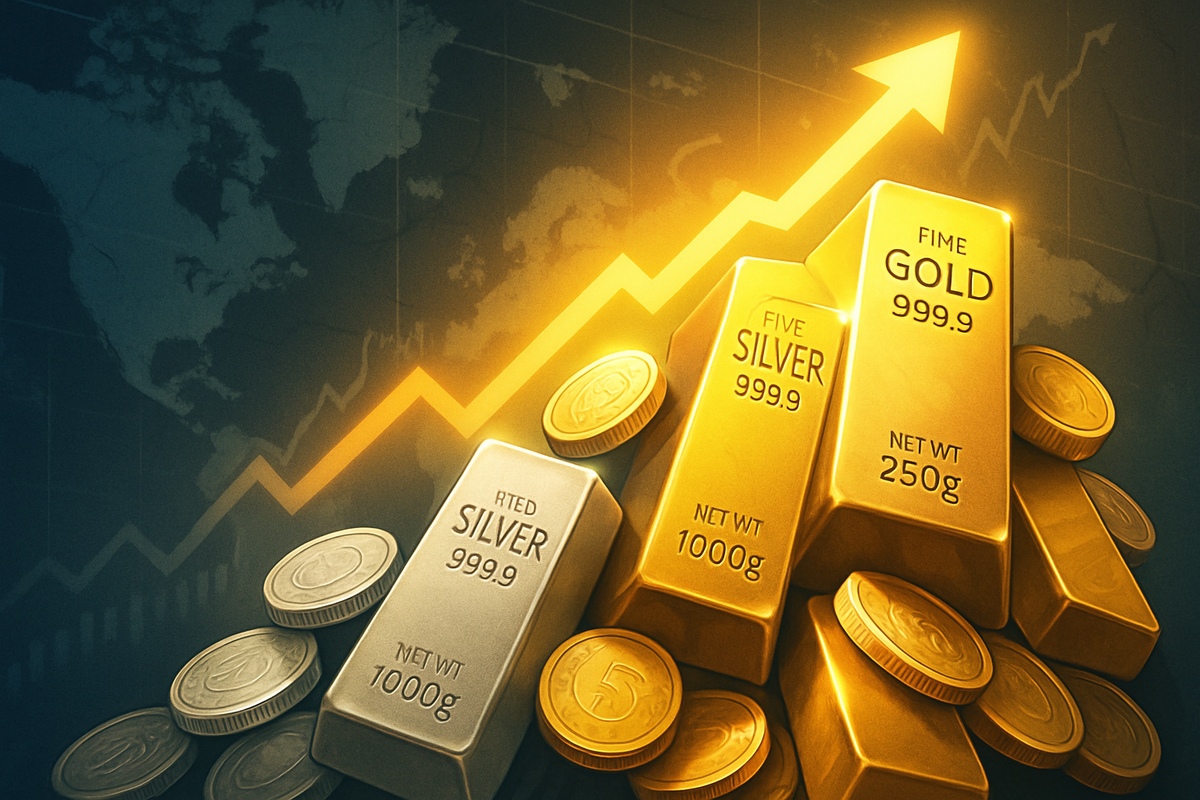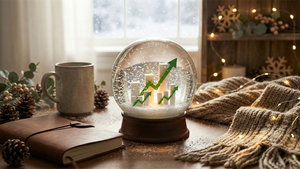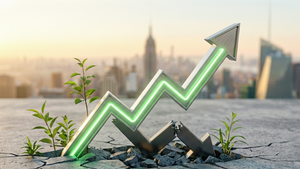
October 16, 2025 – Gold and silver prices have surged to historic, unprecedented levels today, with gold breaching the $4,250 per ounce mark and silver nearing $54 per ounce. This dramatic rally is sending shockwaves through global financial markets, signaling a profound shift in investor sentiment driven by escalating geopolitical tensions and a decidedly dovish outlook from the U.S. Federal Reserve. As a desperate flight to safety takes hold, precious metals are reasserting their role as ultimate safe havens, prompting a re-evaluation of asset allocation strategies worldwide.
The extraordinary ascent of these metals reflects deep-seated anxieties over global economic stability, persistent inflation, and the long-term value of fiat currencies. With central banks globally increasing their gold reserves and investors seeking refuge from a volatile world, the current rally is not merely a fleeting market anomaly but a potential harbinger of a new era for precious metals.
The Perfect Storm: Geopolitics and Monetary Policy Fuel Record Rally
The current rally in gold and silver, as of October 16, 2025, is a culmination of several powerful, converging forces. Gold prices have been on a relentless upward trajectory throughout October, crossing the $4,000 threshold on October 8, reaching $4,179.61 on October 14, and then hitting a record high of approximately $4,251.35 per ounce today. This marks an astounding gain of nearly 60% year-to-date. Silver has mirrored this strength, often outperforming gold in percentage terms, trading around $53 per ounce today, up 1.43% from yesterday and a staggering 69.47% over the past year. In domestic Indian markets, gold has surged to ₹1,28,395 per 10 grams, and silver to a record ₹1,64,660 per kilogram.
The timeline of events leading to this moment began with a breakneck rally in mid-August 2025, intensifying in September as the Federal Open Market Committee (FOMC) initiated its rate-cutting cycle. Federal Reserve Chair Jerome Powell's remarks about a weakening labor market signaled a dovish pivot, reinforced by Governor Christopher J. Waller's comments today supporting continued monetary easing and a likely 25 basis point rate cut at the October 29 FOMC meeting. This dovish stance has weakened the US dollar, making dollar-priced precious metals more attractive to international buyers.
Adding to the monetary impetus are severe geopolitical tensions. An escalating trade war between the US and China, marked by President Trump's threat of 100% tariffs on Chinese imports and Beijing's expanded rare earth export controls, has fueled global uncertainty. A prolonged US government shutdown further contributes to market jitters, delaying crucial economic data and creating policy paralysis. These factors, combined with a global supply crunch in silver (particularly in the London market, where short squeezes have sent lease rates surging) and robust central bank demand (over 600 tonnes purchased in 2025 alone, reflecting a de-dollarization trend), have created a desperate flight to safety.
Winners and Losers: Companies Grapple with Precious Metals Surge
The unprecedented rally in gold and silver has created a clear divide in the market, significantly benefiting companies involved in the extraction and trading of these metals, while posing considerable challenges for others. This surge is translating directly into enhanced profitability and strategic shifts across various industries.
Leading the charge among beneficiaries are gold and silver mining companies. Newmont Corporation (NYSE: NEM / TSX: NGT), the world's largest gold miner, has seen its shares surge over 140% year-to-date, fueled by record gold prices and operational efficiencies. Analysts project substantial free cash flow, with Goldman Sachs upgrading Newmont to a "Buy" rating. Similarly, Barrick Gold Corporation (NYSE: GOLD / TSX: ABX) has rallied 61.3% in the past six months, and Agnico Eagle Mines Limited (NYSE: AEM / TSX: AEM) by 39.7%. Silver miners are also experiencing dramatic gains; Pan American Silver Corp. (NASDAQ: PAAS / TSX: PAAS) has seen its shares soar 77.7% year-to-date, benefiting from its expanded portfolio and strong silver prices. Other significant winners include First Majestic Silver Corp. (NYSE: AG), Hecla Mining Co. (NYSE: HL), and Coeur Mining Inc. (NYSE: CDE). These companies are poised to increase exploration and production, extend mine lives, and potentially engage in strategic mergers and acquisitions.
Precious metals streaming and royalty companies are also flourishing. Wheaton Precious Metals Corp. (NYSE: WPM), the largest in its sector, is trading near all-time highs, with analysts predicting earnings could more than double if gold sustains above $4,000/oz. Franco-Nevada Corporation (NYSE: FNV) and Royal Gold Inc. (NASDAQ: RGLD) similarly benefit from their asset-light models, offering leveraged exposure to rising metal prices without direct mining risks. These companies are likely to see increased deal flow as miners seek upfront capital.
Conversely, certain sectors are feeling the pinch. The jewelry industry, for instance, is facing "slammed" margins due to sharply increased input costs. Retailers are either forced to raise prices, impacting consumer demand, or absorb costs, squeezing profitability. Industrial users of silver, such as electronics manufacturers and solar panel producers, will also face higher material costs, potentially affecting their growth and competitiveness. Companies with extensive hedging at lower prices will miss out on the full upside, effectively subsidizing the market. These sectors may need to pivot towards alternative materials, optimize designs, or implement advanced hedging strategies to mitigate future volatility.
Broader Implications: A Shifting Global Financial Landscape
The unprecedented rally in gold and silver carries profound wider significance, indicating a fundamental recalibration within the global financial landscape. This event is not an isolated incident but rather a symptom of deeper, evolving trends in monetary policy, international relations, and commodity markets.
This surge fits squarely into a broader trend of de-dollarization and a strategic re-evaluation of national reserve assets. Central banks, particularly from BRICS nations, are actively increasing their gold holdings, with 77% of central banks surveyed in 2025 expecting to boost their gold reserves. This reflects a growing distrust in the long-term stability of the U.S. dollar and a desire for greater financial autonomy amidst geopolitical fragmentation. The dovish stance of the Federal Reserve, coupled with persistent inflation, further erodes confidence in fiat currencies, making gold and silver attractive hedges against currency debasement.
The ripple effects are widespread. For competitors in the investment space, the strong performance of precious metals draws capital away from traditional assets like bonds and even equities, especially those perceived as riskier. This necessitates a strategic shift towards more tangible, inflation-protected assets. For partners in the mining sector, such as equipment suppliers and engineering firms, the boom in precious metals mining could translate into increased demand for their services as miners expand operations and exploration efforts. However, rising input costs could also pose challenges for these partners.
Regulatory and policy implications are also emerging. The Federal Reserve's dovish monetary policy will face increased scrutiny regarding its effectiveness in managing inflation and supporting economic growth without further destabilizing currency values. The physical market tightness, particularly in silver (described as a "state of seizure" in London), could prompt calls for increased regulatory oversight of commodity markets to address potential manipulation or supply chain vulnerabilities. Furthermore, ongoing trade tensions and tariffs, which contribute to global uncertainty and safe-haven demand, may be re-evaluated by governments in light of their broader economic impacts.
Historically, this rally draws parallels with the 1970s bull market (1978-1980), when gold quadrupled amidst double-digit inflation, oil shocks, and geopolitical crises like the Iranian Revolution. Similar to today, that period saw a "desperate flight to safety" into precious metals. The 2008 Great Recession and the COVID-19 pandemic also saw gold hit record highs as investors sought refuge from economic uncertainty and unprecedented monetary easing. The current rally, however, is unique in its confluence of aggressive central bank dovishness, intense geopolitical friction, and significant industrial demand for silver, particularly from the booming green energy sector.
What Comes Next: Navigating a New Era for Precious Metals
The unprecedented surge in gold and silver prices, driven by a complex interplay of geopolitical tensions and a dovish Federal Reserve, sets the stage for a dynamic and potentially volatile future for these markets. Stakeholders across the financial spectrum must prepare for strategic pivots and adapt to emerging opportunities and challenges.
In the short-term (next 6-12 months), the bullish momentum is expected to largely continue. Analysts at ANZ Group Holdings Ltd. project gold to reach $4,400 per ounce by year-end 2025 and potentially peak near $4,600 by June 2026. Silver is forecasted to hit $57.50 per ounce by mid-2026, with some aggressive projections reaching $65. However, the market should brace for increased volatility and potential short-term corrections of 10-20% for silver, especially after festive buying in India tapers off, and 10-15% for gold, as profit-taking occurs. These pullbacks, however, are likely to be healthy corrections within a broader uptrend, supported by strong underlying drivers.
Looking long-term (beyond 12 months), the outlook remains predominantly bullish. Gold is projected to average around $4,150 per ounce in 2026 by ING, with Goldman Sachs targeting $4,900 by the end of 2026, and Bank of America forecasting $5,000. Some even more aggressive projections from J.P. Morgan and Jefferies suggest gold could reach $6,000 per ounce under specific conditions. Silver is anticipated to outperform gold, potentially reaching $75-77 per ounce by 2026-2027, driven by its dual role as a monetary and increasingly critical industrial metal for the green energy transition.
Strategic pivots are essential. Investors are advised to diversify portfolios, increasing allocations to tangible assets like physical bullion, precious metal ETFs (e.g., SPDR Gold Shares (NYSEARCA: GLD), iShares Gold Trust (NYSEARCA: IAU)), and mining company ETFs (e.g., VanEck Gold Miners ETF (NYSEARCA: GDX)). Silver, often seen as undervalued relative to gold, presents a significant opportunity for leveraged exposure. Mining companies must seize this period of high profitability to increase exploration and development, optimize supply chains, and invest in sustainable practices to address declining ore grades and rising costs. Central banks are expected to continue their gold accumulation, solidifying the de-dollarization trend and diversifying their reserves.
Emerging market opportunities include the burgeoning demand for silver, platinum, palladium, and rhodium in green technologies like solar panels, electric vehicles, and fuel cells, positioning silver as a "monetary metal for the decarbonized age." Conversely, challenges include persistent supply chain vulnerabilities due to geopolitical tensions and labor shortages, increased regulatory scrutiny over commodity markets, and the potential for illicit trafficking of high-value metals.
Potential scenarios include a base case of elevated prices with increased volatility, where gold consistently trades above $4,000 and silver above $50. A bull case could see gold surge towards $5,000-$6,000 and silver to $60-$78 if geopolitical conflicts escalate further or the U.S. dollar weakens dramatically. A bear case, though less likely given current drivers, would involve a significant market correction (10-20% or more) if geopolitical tensions abate swiftly or the Fed unexpectedly adopts a hawkish stance.
Wrap-Up: A Golden Future, But Vigilance is Key
The current rally in gold and silver marks a pivotal moment in financial history, driven by an potent combination of escalating geopolitical tensions, a dovish Federal Reserve, and fundamental supply-demand dynamics. The key takeaways are clear: precious metals are reasserting their role as indispensable safe-haven assets and hedges against inflation and currency debasement.
Moving forward, the market is poised for sustained higher prices, though not without increased volatility. Gold has proven its resilience as a store of value, while silver's dual monetary and industrial demand positions it for potentially even greater gains, especially in the context of the global green energy transition. The ongoing de-dollarization trend among central banks underscores a fundamental shift in global financial architecture.
Investors should watch closely for further developments in geopolitical hotspots, particularly US-China relations, and any shifts in the Federal Reserve's monetary policy trajectory. The pace of central bank gold accumulation, industrial demand growth for silver, and potential regulatory responses to market dislocations will also be critical indicators. While the long-term outlook for precious metals appears robust, prudence and diversification remain paramount in navigating this new, dynamic era.
This content is intended for informational purposes only and is not financial advice







